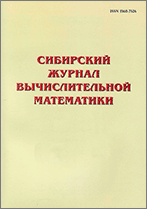|
|
Sibirskii Zhurnal Vychislitel'noi Matematiki, 2014, Volume 17, Number 3, Pages 217–227
(Mi sjvm544)
|
|
|
 |
This article is cited in 2 scientific papers (total in 2 papers)
A cellular automata model of three organisms populations in lake Baikal
I. V. Afanasyev
Institute of Computational Mathematics and Mathematical Geophysics SB RAS, 6 Lavrentjev pr., Novosibirsk, 630090, Russia
Abstract:
A cellular automata model of population dynamics of three organisms in Lake Baikal is proposed and investigated. Each species is divided into age groups. There are eight groups all together. The model allows one to take into account a spatial organisms distribution, a seasonal dependency of birth rates, a possible habitat pollution and water streams. A computational experiment was carried out for the case of pollution that is in the south area of lake Baikal. It demonstrates that the population dynamics tends to the oscillating process with a period equal to 1 year. The assessment of the critical pollution intensity which leads to the total extinction is presented. The model was verified within production-to-biomass and frequency of occurrence ratios.
Key words:
cellular automata, discrete modeling, populations dynamics, lake Baikal, prey-predator systems.
Received: 17.07.2013
Revised: 09.01.2014
Citation:
I. V. Afanasyev, “A cellular automata model of three organisms populations in lake Baikal”, Sib. Zh. Vychisl. Mat., 17:3 (2014), 217–227; Num. Anal. Appl., 7:3 (2014), 181–190
Linking options:
https://www.mathnet.ru/eng/sjvm544 https://www.mathnet.ru/eng/sjvm/v17/i3/p217
|

| Statistics & downloads: |
| Abstract page: | 391 | | Full-text PDF : | 159 | | References: | 88 | | First page: | 4 |
|




 Contact us:
Contact us: Terms of Use
Terms of Use
 Registration to the website
Registration to the website Logotypes
Logotypes







 Citation in format
Citation in format 
